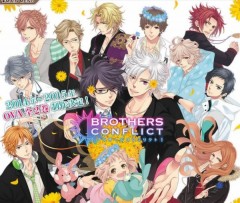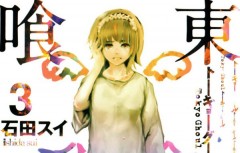 Gifted with the power of seven Djinn, fourteen-year-old Ichika must face a series of trials that puts her life at risk.
Gifted with the power of seven Djinn, fourteen-year-old Ichika must face a series of trials that puts her life at risk.
What They Say:
Before you make a deal with a girl in a mirror, reflect seriously on the source of the offer. Ichika Tachibana fails to take this advice in order to retrieve a lost charm, and as a result suddenly ends up with the magical forces of a Djinn at her command. Sounds like a good deal, right? Wrong. At first, things seem wondrous, with her new friend Manatsu assisting her via text messages and the occasional spell; but as her powers grow, Ichika’s situation quickly goes from magical to nightmarish, and she finds herself drawn into an ever expanding web of deceptions, lies, and increasingly dangerous situations. For what she’s really done is subjected herself to seeing mankind as the Djinn see them. Unfortunately, they don’t seem to place a high value on human life.
The Review:
Audio:
The audio presentation for this series comes with the Japanese track in stereo encoded at 224kbps. The show is mostly focused around a basic slice of life dialogue and friendly scenes as opposed to the bigger moments so the mix doesn’t provide much of a workout. When it does stretch its wings a little it’s mostly in the music and the occasional sweeping scene when the Djinn are in action. The dialogue aspect of the show is well handled with some decent placement to it but not all that much in the way of noticeable depth. The show isn’t one that really stands out when it comes to the audio but it’s well done and problem free.
Video:
Originally airing in 2004, the transfer for this TV series and OVA is presented in its original full frame aspect ratio. The show is spread across two discs with six on the first and seven on the second due to the length of the extras on the first. The show has a good visual design to it with a strong real-world approach that has lots of good colors to it and a very nice level of detail. The transfer captures the colors well with richness and vibrancy when needed and the dark areas manage to avoid any significant blocking and noise though a little creeps into some of the blues at times. There’s nothing that really stands out badly here as the source is well captured and presented which should please the majority of fans.
Packaging:
Utakata gets a standard Sentai release in that the two-disc collection is inside a single sized keepcase. The front cover has a strong theatrical feeling to it with the two leads running hand in hand with a long shot of the city behind them. The colors for it are very rich and appealing and the detail is far stronger than most shows get. The logo is also really nicely done along the bottom with the way the swirl wraps around it. The back cover is nicely laid out as well with an appealing shot of the two leads together in warmer clothes holding handles set against a cool winter sky. On each side of them, there’s a good number of shots from the show that highlights the appealing designs and gives you a lot to look at. The summary is far more detailed than I expected as well with a small font and a lot of text carried across both sides. The bottom brings out the episode and disc count well while also detailing the extras rather nicely so you know what you get. The rest is the usual production credits and technical information.
Menu:
The menu design for the series is good overall with it split in an almost fifty/fifty style with character artwork on the right and the navigation along the left. The character artwork has the same kind of detailed feeling we get from the cover design and each of them is different. The navigation side has a very light feeling to it with whites and ice blues that breaks down the episode numbers and titles. Since there are real extras on each disc, submenus are a bit more useful since there’s no language submenus and everything loads quickly and smoothly with no problems. The menus are decently in theme and gives you an almost otherworldly feeling when it loads up and sets you into the right mindset for it.
Extras:
The extras for this release are spread across two discs due to the size of a couple of them. The first disc has the two specials which run ten and fourteen minutes respectively that covers some of the location scouting and background done on creating the set design. The second disc has a bunch of smaller extras to it that are fun, such as the copyright and safety warnings that were aired with the show originally. The alternate episode previews are included as well as the clean opening and closing sequences.
An original story from Bandai Visual, Utakata is a twelve episode series with an epilogue OVA that tells something of a magical girl story. Taking the overall premise and applying it to a slice of life series with a seriousness to it, Utakata tries to stand out and be something more but has a hard time doing it. In fact, much of the idea behind the show doesn’t really come out until the end, though it hints at aspects of it along the way. This leaves the show in an odd place where you’re curious about what it’s really about but the payoff doesn’t feel like it’s strong enough once you get there.
The story of Utakata revolves around fourteen-year-old Ichika, a friendly and likable girl who has a good group of friends and supportive parents. She’s got some friends she likes more than others, some she has some trouble with and there’s a boy she might have some slightly stronger feelings for. Ichika has had some strange dreams recently of a green haired girl that seems friendly but then turns to either her or the stranger strangling the other and threatening to kill her. It’s startling to be sure but becomes even more so later on when she spends time doing end of semester cleaning in one of the side buildings of the school. Within a mirror there, she sees the same girl who comes out of it and wants to befriend her. It’s almost surreal that Ichika agrees to it and Manatsu ends up spending the summer at her home as a penpal that’s suddenly come to stay.
 While there is a logical reason to it that is eventually explained, a lot of points in the show has these kinds of surreal moments where it doesn’t flow well in how, well, reality would work. Granted we’re dealing with a magical girl show done differently, but some of the basic real world situations end up going in this direction which makes it come across awkwardly. Even in the magical girl arena it has this feeling. Matsuna’s introduction is that she’s from another world of sorts, something Ichika believes easily enough, and she adjusts a special piece of jewelry that Ichika has with seven jewels on it. Each of those jewels represents a Djinn (and a trial) that Ichika must overcome as she can take on the Djinn’s special power.
While there is a logical reason to it that is eventually explained, a lot of points in the show has these kinds of surreal moments where it doesn’t flow well in how, well, reality would work. Granted we’re dealing with a magical girl show done differently, but some of the basic real world situations end up going in this direction which makes it come across awkwardly. Even in the magical girl arena it has this feeling. Matsuna’s introduction is that she’s from another world of sorts, something Ichika believes easily enough, and she adjusts a special piece of jewelry that Ichika has with seven jewels on it. Each of those jewels represents a Djinn (and a trial) that Ichika must overcome as she can take on the Djinn’s special power.
Interestingly, the Djinn and its power are used rather sparingly and for seemingly inconsequential things. Well, inconsequential to anyone else but important to Ichika. It feels like a regular theme that she uses it to find her friends who may be lost or away when she needs them. It’s more towards the end of each episode and I liked that each Djinn summoning gives her a different outfit with familiar themes across all of them. But the way she uses the powers doesn’t even feel like it’s right for a fourteen-year-old girl. I’m not expecting Western style superheroics or the fun of Sailor Moon, but Ichika’s use of its powers is generally very selfish and inconsequential.
 With Utakata trying to straddle the line by being more mature, it doesn’t exactly reach it. One of the things that it does to stand out is to deal with more serious issues that her friends go through. Betrayal of love is one as well as some form of child abuse that is dealt with in a very obscure kind of way. I did like that she has very different relationships with the people she calls friends. There are some that are close and others that are casual, but there’s a sense that she’s not been able to get close to some of them. There’s an underlying issue with why she’s pulling away from them as the show moves forward, and you can get it through the narration, but it’s something that’s thrown out towards the end that doesn’t help the show and instead feels like an awkward monkey wrench in things.
With Utakata trying to straddle the line by being more mature, it doesn’t exactly reach it. One of the things that it does to stand out is to deal with more serious issues that her friends go through. Betrayal of love is one as well as some form of child abuse that is dealt with in a very obscure kind of way. I did like that she has very different relationships with the people she calls friends. There are some that are close and others that are casual, but there’s a sense that she’s not been able to get close to some of them. There’s an underlying issue with why she’s pulling away from them as the show moves forward, and you can get it through the narration, but it’s something that’s thrown out towards the end that doesn’t help the show and instead feels like an awkward monkey wrench in things.
What I found irked me the most is that as it progresses is the way it’s all playing a larger game with Ichika. Through the narration, we learn that she discovers that many people are watching her and that puts everyone under suspicion. The most obvious is the beautiful woman who lives next door named Saya, but everyone feels like they’re in on what Ichika is going through and seeing how she’s going to survive this mysterious test. And having the test be a mystery for so long doesn’t help either. With each new little nod towards it and the apparent undisclosed importance of it, I felt more and more on the outside of a joke and it kept me from getting connected with it. Manatsu being so involved in it and being reminded that she can’t say anything since it’s against the rules only added to the frustration.
In Summary:
Utakata is an interesting take on the magical girl genre but not one that really stands out heavily. It takes things in a more serious manner than most but it’s one that feels oddly unbalanced. The drama side of it gets the most attention which means the magical girl side gets short changed and it impacts it badly. The Djinn and Ichika’s use of them are mostly inconsequential and pointless, where it’s not something you can imagine any fourteen-year-old doing. Utakata has some neat visuals to it and I liked the variety to the Djinn and her costumes but the story itself kept pushing me away and made me feel like I was very much on the outside of it and it didn’t want to let me in on what it was really about until the end.
Features:
Japanese 2.0 Language, English Subtitles, Clean Opening, Clean Closing, Uta-kata specials, Piracy and copyright warnings, On-air previews
Content Grade: C
Audio Grade: B
Video Grade: B+
Packaging Grade: A-
Menu Grade: B
Extras Grade: B
Released By: Sentai Filmworks
Release Date: November 2nd, 2010
MSRP: $49.98
Running Time: 325 Minutes
Video Encoding: 480i/p MPEG-2
Aspect Ratio: 1.78:1 Anamorphic Widescreen
Review Equipment:
Sony KDL70R550A 70″ LED 1080P HDTV, Sony PlayStation3 Blu-ray player via HDMI set to 1080p, Onkyo TX-SR605 Receiver and Panasonic SB-TP20S Multi-Channel Speaker System With 100-Watt Subwoofer.























